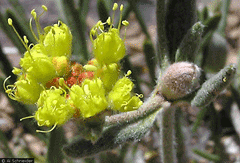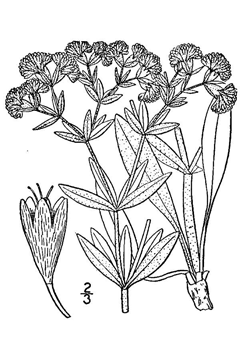 |
|
Al Schneider @ USDA-NRCS PLANTS Database |
 |
| USDA-NRCS PLANTS Database / Britton, N.L., and A. Brown. 1913. An illustrated flora of the northern United States, Canada and the British Possessions. Vol. 1: 649. |
Translate this page:
Summary
Physical Characteristics

 Eriogonum jamesii is a PERENNIAL growing to 0.3 m (1ft) by 0.5 m (1ft 8in).
Eriogonum jamesii is a PERENNIAL growing to 0.3 m (1ft) by 0.5 m (1ft 8in).
See above for USDA hardiness. It is hardy to UK zone 4. It is in flower from August to September. The species is hermaphrodite (has both male and female organs).
Suitable for: light (sandy) and medium (loamy) soils, prefers well-drained soil and can grow in nutritionally poor soil. Suitable pH: mildly acid, neutral and basic (mildly alkaline) soils. It cannot grow in the shade. It prefers dry or moist soil. The plant can tolerates strong winds but not maritime exposure.
UK Hardiness Map
US Hardiness Map
Synonyms
Plant Habitats
Cultivated Beds;
Edible Uses
References More on Edible Uses
Medicinal Uses
Plants For A Future can not take any responsibility for any adverse effects from the use of plants. Always seek advice from a professional before using a plant medicinally.
Analgesic Cardiac Contraceptive Ophthalmic Stomachic
Some native North American Indian tribes used this plant as a contraceptive. The women would drink one cup of a decoction of the root during menstruation[213]. A decoction of the whole plant has been drunk to ease the pain of childbirth[257]. The root has been chewed as a cardiac medicine and as a treatment for stomach aches[257]. An infusion of the roots has been used to treat despondency[257]. The infusion has also been used as a wash for sore eyes[257]. The plant has been chewed to sweeten the saliva[257].
References More on Medicinal Uses
The Bookshop: Edible Plant Books
Our Latest books on Perennial Plants For Food Forests and Permaculture Gardens in paperback or digital formats.

Edible Tropical Plants
Food Forest Plants for Hotter Conditions: 250+ Plants For Tropical Food Forests & Permaculture Gardens.
More

Edible Temperate Plants
Plants for Your Food Forest: 500 Plants for Temperate Food Forests & Permaculture Gardens.
More

More Books
PFAF have eight books available in paperback and digital formats. Browse the shop for more information.
Shop Now
Other Uses
References More on Other Uses
Cultivation details
Requires a loose lean gritty well-drained soil in a very sunny position[200]. Succeeds in dry soils. Tolerates exposed positions[200]. Requires some protection from winter wet[1]. Established plants deeply resent root disturbance[200].
References Carbon Farming Information and Carbon Sequestration Information
Temperature Converter
Type a value in the Celsius field to convert the value to Fahrenheit:
Fahrenheit:
The PFAF Bookshop
Plants For A Future have a number of books available in paperback and digital form. Book titles include Edible Plants, Edible Perennials, Edible Trees,Edible Shrubs, Woodland Gardening, and Temperate Food Forest Plants. Our new book is Food Forest Plants For Hotter Conditions (Tropical and Sub-Tropical).
Shop Now
Plant Propagation
Seed - best sown as soon as it is ripe in the autumn in a sandy compost in a greenhouse. Sow stored seed in early spring in a warm greenhouse[1]. As soon as they are large enough to handle, prick the seedlings out into individual pots and grow them on in the greenhouse for at least their first winter. Plant out in late spring or early summer, after the last expected frosts. Division in early spring[1]. This has to be done with care because the plant resents root disturbance[200]. Try to obtain divisions from around the edges of the plants without digging up the whole clump. Tease the divisions out with as much root on them as possible and pot them up. Grow them on in light shade in the greenhouse until they are rooting well and plant them out in the summer. Cuttings of greenwood with a heel in the summer[200].
Other Names
If available other names are mentioned here
Native Range
NORTHERN AMERICA: United States (Kansas, Oklahoma, Colorado, New Mexico, Texas, Arizona), Mexico (Chihuahua, Coahuila de Zaragoza, Durango, Nuevo León, San Luis Potosí, Tamaulipas, Zacatecas)
Weed Potential
Right plant wrong place. We are currently updating this section.
Please note that a plant may be invasive in one area but may not in your area so it's worth checking.
Conservation Status
IUCN Red List of Threatened Plants Status :

Growth: S = slow M = medium F = fast. Soil: L = light (sandy) M = medium H = heavy (clay). pH: A = acid N = neutral B = basic (alkaline). Shade: F = full shade S = semi-shade N = no shade. Moisture: D = dry M = Moist We = wet Wa = water.
Now available:
Food Forest Plants for Mediterranean Conditions
350+ Perennial Plants For Mediterranean and Drier Food Forests and Permaculture Gardens.
[Paperback and eBook]
This is the third in Plants For A Future's series of plant guides for food forests tailored to
specific climate zones. Following volumes on temperate and tropical ecosystems, this book focuses
on species suited to Mediterranean conditions—regions with hot, dry summers and cool, wet winters,
often facing the added challenge of climate change.
Read More
Expert comment
Author
Benth.
Botanical References
200228
Links / References
For a list of references used on this page please go here
Readers comment
| Add a comment |
|
If you have important information about this plant that may help other users please add a comment or link below. Only comments or links that are felt to be directly relevant to a plant will be included. If you think a comment/link or information contained on this page is inaccurate or misleading we would welcome your feedback at [email protected]. If you have questions about a plant please use the Forum on this website as we do not have the resources to answer questions ourselves.
* Please note: the comments by website users are not necessarily those held by PFAF and may give misleading or inaccurate information.
To leave a comment please Register or login here All comments need to be approved so will not appear immediately.
|
Subject : Eriogonum jamesii
|
|
|
|